
Goats in Medicine: 1 2 3 4 Next>>
Goats in Medicine During the Golden Age of Piracy, Page 2
The Bezoar Stone - Uses
In addition to being recognized as an antidote, many other properties were attributed to the bezoar stone by various authors.A skeptical Ambroise Parė used the writings of Garcia ab Berto as guide to the bezoar's properties, explaining that it was used "in inveterate melancholick diseases, as the itch, scab, tetters and leprosie; therefore by the same reason it may well bee given again a quartane fever. Besides, hee [ab Berto] affirmeth for certain that the powder contained in the midst of the stone, put upon the bites of venomous beasts, presently free'th the patient from the danger of the poison, as also applied to pestilent Carbuncles when they are opened, it draw's forth the venom. But becaus the small pocks and measles are familiar in the Indies, and oftimes dangerous, it is there given with good success, two grains each dai in Rose-water."1
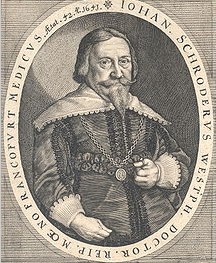
Physician Johann Schröder
Parė lists a couple other uses in his discussion of the bezoar. "The richer sort of the Countrie [Persia] purge twice a year, to wit, in March and September; and then, five daies together they take the powder of this stone macerated in Rose-water, the weight of ten grains at a time: for by this remedie they think their youth is preserved, as also the strength of their members."2
Although he doubts the bezoar's healing attributes, physician Robert James cites qualities listed in Johann Schröder's book The Apothecary or a Treasure Chest of Valuable Medicines (1685) which claim it is "a promoter of Sweat; is good in Epilepsies, Palpitations of the Heart, Jaundice, Dysenteries, Stone, and obstruction of the Menses; it cures Melancholy, and promotes Delivery"3.
French physician Pierre Pomet explained that it was "esteem'd as a great Cordial [soothing or 
Author and Physician Pierre Pomet
relaxing medicine], proper to promote Sweat, and drive away malignant Humours."4 He also reveals other uses, including many that appear to come from Schroder's book.
He also suggests that it "is a Preservative from pestilential Air, and a Remedy for the Small-Pox, Measles, or other contagious Diseases."5
Pomet also tells us that "Schroder assigns the dose from three Grains to twelve" which is basically what he himself recommends, bumping the lower number up from three to four.6 James suggests the appropriate amount given should be "from four Grains to ten or a dozen in any Cordial, or other proper Liquor."7 He does note that "our Physicians prescribe it in much larger Doses ...others have ventured half a Dram, or a Dram at a time."8 Parė suggests an outrageous amount is sometimes given, explaining that "[t]here bee some who take the weight of thirtie drams; yet the more warie exceed not twelv grains."9
Our period sea doctors provide several direct examples of how the bezoar could be employed. In his 1640 book on creating a medicine chest 'for land or sea' German surgeon Gulielmus Fabricius Hildanus lists a 'Bezoar 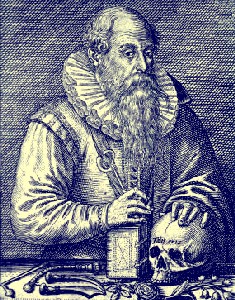
Physician Guilielmus Fabricius Hildanus
Stone.'10 John Woodall's 1617 book, which also list medicines to be included in a sea-surgeon's medicine chest, notably does not include one.11 Woodall does not suggest any doubts about the efficacy of the bezoar, however. In fact he lists it among the ingredients required to make Ladanum Paracelsi12 which Woodall proclaims "exceedeth all Narcotics."13 It is quite likely that Woodall excludes it due to its rarity and expense, since he was in charge of the making of the sea-going medicine chests for the East India Company and, later, the British Royal Navy.
Sea surgeon John Atkins lists it among the alexipharmics for treating gangrenes without offering an opinion on its value in that capacity.14 Fellow sea practitioner John Moyle recommends it as part of a medical compound for treating a blood clot in the kidneys, which he calls fluida cruror. "To Cure, do this: Rx. Bezoar. Min. Gr. 12. [minimum 12 grains] Antimo Diaphoret. [Antimony diaphoretic?] {1 scruple} misce. f. Bol. [mixed and made into a bolus]"15. This was to be prepared and administered every morning to the patient. Note that Moyle's prescription was probably not for use at sea, however.
Sea physician Thomas Aubrey uses the bezoar in a concoction made at sea which was used to treat seaman Joseph Booth. Following the administration of the Goat's Head Broth enema (as will discussed shortly), Aubrey explains that have gave Booth "the following Bolus once in six Hours, for four several Times successively. Rx. Oc. Cancr. [crab's eyes - actually calcinated stones found inside the stomach of European crawfish] ppt. [prepared with] {12 grains} Bezoar. Mineral {6 grains} Cons. Synosbat. [gooseberry conserve] s. q. m f. Bolus. [make a sufficient quantity of the bolus]"16 How you possibly can beat a concoction of crab's eyes and goat's stone in gooseberry jelly as a curative, I couldn't say.
1 Ambroise Paré, The Workes of that Famous Chirurgion Ambrose Parey, p.529; 2 Paré, ibid.; 3 Robert James, Pharmacopœia universalis, p. 486; 4 Pierre Pomet, The Compleate History of Druggs, 3rd Edition, p. 237; 5 Pomet, p. 236; 6 Pomet, p. 236; 7 James, p. 486; 8 Ibid.; 9 Paré, ibid.; 10 Gulielmus Fabricius Hildanus, Cista Militaris, Or, A Military Chest, Furnished Either for Sea or Land, p. 13; 11 See John Woodall, the surgions mate, "A Note of the Particular Ingrediences due to the Surgeons Chest" in the introductory sections; 12 Woodall, p. 228; 13 Woodall, p. 239; 3 John Atkins, The Navy Surgeon, p. 131; 6 John Moyle, Memoirs: Of many Extraordinary Cures, p. 125; 16 Thomas Aubrey The Sea-Surgeon or the Guinea Man’s Vadé Mecum., p. 131-2
The Bezoar Stone - Value
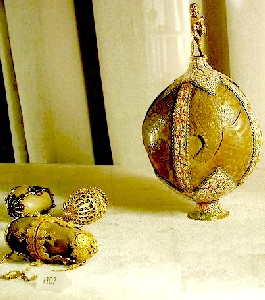
Various-Sized Bezoars as Ornaments, from
the
Treasury Chamber of the Wittelsbache, Munich
Because they came from so far away and were uncommon, bezoar stones were very valuable despite the controversy surrounding their value in medicine. As can be seen in the images here, some of them were notable enough to have been turned into ornatments. Writing in the 16th century, Ambroise Parė explains,
...at first it [the bezoar] was common amongst us, and of no verie great price, becaus our people who trafficked in Persia, bought it at an easie rate. But after that the faculties thereof were found out, it began to be more rare and dear, and it was prohibited by an Edict from the King of the Countrie, that no bodie should sell a Goat to the stranger-Merchants, unless he first killed him and took forth the stone, and brought it to the King.1
Like any curiosity, the bezoar's price became an extension of their rarity. Pierre Pomet explained that "the larger the Bezoar is, the dearer 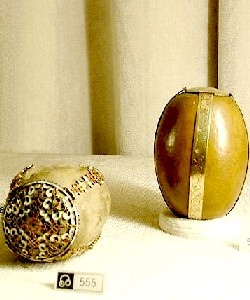
Large Bezoars as Ornaments, from
The
Treasury
Chamber of the Wittelsbache, Munich
it is, and rises in Proportion as a Diamond: For if five or six Bezoar Stones weigh one Ounce, that Ounce will be worth from fifteen to eighteen or twenty Livres; but if it be one Stone of an Ounce weight, it will sell for a hundred Livres. I have sold one of four Ounces and a Quarter for two thousand Livres."2
This is part of the reason the true medicinal nature of the bezoar was so hard to determine. Robert James tells his readers, "the excessive price it generally bears, makes it inconvenient to exhibit it in a great Number of Cases, and that in sufficient Quantities, and those long enough continued, to determine, whether the Virtues attributed to it are real or imaginary"3.
It is quite a comment on the perversity of human nature that something so base as the gall stone found in the stomach of a goat could become not only prized as a medicine, but an object d'art. As Pomet explains in a more thoughtful moment, "The Use of Bezoar was formerly very common, but at present we scarce know what it is, by reason of the Iniquity of the Times, and its extravagant Price, or that it grows out of Fashion; for Medicines have Modes as well as Clothes"4.
1 Ambroise Paré, The Workes of that Famous Chirurgion Ambrose Parey, p.529; 2 Pierre Pomet, The Compleate History of Druggs, 3rd Edition, p. 235; 3 Robert James, Pharmacopœia universalis, p. 487; 4 Pomet, p. 236
The Bezoar Stone - Counterfeits
"Many Circumstances contribute to render the medicinal Virtues of Bezoar precarious, and not easy to be determin'd, as the Uncertainty of procuring that which is genuine, it being much adulterated, as is said, even in the Indies; not to mention the large Quantities that are made in Europe, in imitation of the true." (Robert James, Pharmacopœia universalis, p. 486-7)
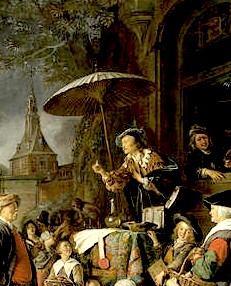
Artist: Gerrit Dou
The Quack (1652)
Like all rare and valuable commodities, bezoar stones attracted unsavory sellers, James explained in his comments above about bezoars being adulterated. Ambroise Parė notes that "manie counterfeits brought hither [to France]"1 while Pierre Poment advised his readers that "there is oftentimes a Cheat."2 Pomet goes on to warn that "there are People who powder and mix Bezoar in a certain Paste compos'd of a Gum, and something else of the Colour of Bezoar, and form it up in the same Manner as we see the natural Bezoar"3.
So it was the responsibility of the buyer to determine whether a bezoar was true or not. Each author recommended tests which are sometimes as curious as the long lists of illnesses it was claimed the bezoar could cure.
James first noted that other authors suggested using color as a test, but as we have seen bezoars came in many different colors. He goes on to suggest that a true stone would one 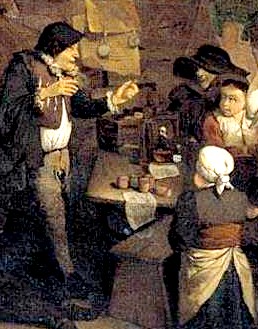
Artist: Cornelis Pietersz Bega
Village Market with the Quack (1650s)
that would "communicate a yellow Colour to Quicklime, a greenish one to Chalk, and which cannot be dissolv'd in Water."4 He also
advises a second test. "If prick'd with a hot Iron, no Bubbles ought to arise round the Iron, which is a Proof, that it is not adulterated with any Resins."5
Parė explains that a true bezoar can be rasped and will dissolve "if long macerated in water" as we have already seen. He suggests another test that seems rather novel. He advises the buyer that the bezoar "may be blown up by the break [in the stone, presumably], like an oxe's hide; for if the winde break through, and do not stay in the densitie thereof, it is accounted counterfeit."6
Pomet advises testing stones in two ways, one of which is by using a hot iron as James recommended, which will cause the counterfeit 'to fry', presumably as whatever was used to make the fake bezoar stick together heats up and bubbles as James explains. Pomet's other test is to weigh the stone, after which the buyer should "steep it some Time in warm Water; and if the Water does not change it's Colour, or the Bezoar lose its Weight, it is true and natural."7
1 Ambroise Paré, The Workes of that Famous Chirurgion Ambrose Parey, p.529; 2 Pierre Pomet, The Compleate History of Druggs, 3rd Edition, p. 235; 3 Pomet, ibid.; 4 Robert James, Pharmacopœia universalis, p. 486; 5 James, ibid.; 6 Paré, ibid.; 7 Pomet, ibid.
The Bezoar Stone - Debunking the Myth
Astonishingly, the curative properties of the bezoar were shown to be false by Ambroise Parė about a century before the golden age of piracy. Parė conducted what has to be one of the earliest 'formal' scientific medical tests in print. It is an interesting tale, so let's read it in full. Note that I have added some paragraph breaks for readability.
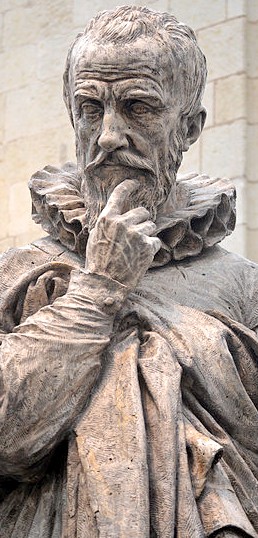
Photographer: Selby May
Artist: David d'Angers
A Statue of a Thoughtful Ambroise Parė
Som years ago, a certain Gentleman who had one of these stones which hee brought out of Spain, bragged before King Charls then being at Clermount in Avern, of the most certain efficacie of this stone against all manner of poisons. Then the King asked of mee, whether there were anie Antidote which was equally and in like manner prevalent against all poisons?
I answered, that nature could not admit it; for neither have all poisons the like effects, neither do they arise from one caus; for som work from an occult and specific propertie of their whole nature, others form som elementary qualitie which is predominant. Wherefore each must bee withstood with its proper and contrarie antidote; as to the hot, that which is cold [he is here referring to humoral theory], and to that which assails by an occult propertie of form, another which by the same force to oppugn it, and that it was an easie matter to make trial hereof on such as were condemned to be hanged.
The motion pleased the King, there was a Cook brought by the Jailor who was to have been hanged within a while after for stealing two silver-dishes out of his master's hous. Yet the King desired first to know of him, whether Hee would take the poison on this condition, that if the Antidote which was predicated to have singular power against all manner of poisons, which should bee presently given him after the poison, should free him from death, that then hee should have his life saved. The Cook answered cheerfully, that hee was willing to undergo the hazard, yea, and greater matters, not onely to save his life, but to shun the infamie of the death he was like to be adjudged to.
Therefore hee then had poison given him by the Apothecarie that then waited, & presently after the poison, som of the Bedezabar brought from Spain, which being taken down, within a while after hee began to vomit, and to [void] much by stool with grievous torments, and to crie out that his inward parts were burn't with fire.
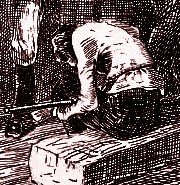
Taken from Captain William
Kidd and Others of the Pirates
or Buccaneers, p. 270 (1834)
Wherefore being thirstie, and desiring water, they gave it him; and hour after, with the good leav of the Jailor, I was admitted to him; I finde him on the ground going like a beast upon hands and feet, with his tongue thrust forth of his mouth, his eies fierie, vomiting, with store of cold sweats, and lastly, the blood flowing forth by his ears, nose, mouth, fundament and yard. I gave him eight ounces of oil to drink but it did him no good, for it came too late.
Wherefore at length hee died with great torment and exclamation, the seventh hour from the time that hee took the poison being scarcely passed. I opened his bodie in the presence of the Jailor and four others, and I found the bottom of his stomach black and drie, as if it had been burn't with a Cauterie; whereby I understood he had sublimate given him; whose force the Spanish Bedezabar could not repress, wherefore the King commanded to burn it.1
So much for the bezoar! Or so you would think. However, this remedy hung around for several hundred years after published his account. This could have been in part because not everyone had read Parė's book, but it may also be due to the slippery nature of myths. (As the nature and number of myths we find today will testify.) In this case the quality of Parė's stone was questioned.
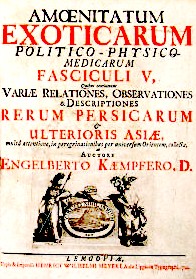
Amoenitatum Exoticarum According to J.J. Kent, period naturalist Engelbert Kaempfer explained in his 1712 book Amoenitatum Exoticarum "that Pare's bezoar may have been of inferior quality, and, moreover, bezoars could not be successfully used to counteract mineral poisons, but were only useful when vegetable poisons had been taken."2
Robert James was skeptical, but he kept an open mind which was probably another reason the bezoar hung around for so long. Medicine was a most inexact science at this time in history. James explains, "I am informed from Physicians, who have industriously attempted to make the proper Experiments, that it has no Sort of medicinal Virtues, that they could perceive, which might give it the Preference to the testaceous [shell-based] Powders. I cannot, however forbear thinking, that if we had the genuine Bezoar Stone, we should find it endow'd with greater medicinal Virtues, than at present we have any Reason to believe it possessed of."3 So the rarity of the bezoar helped contribute to it's use... which helped contribute to its rarity, and so forth.
We save the last word on this object for privateer physician Thomas Dover. Dover was one of the sponsors of as well as the physician on Woodes Rogers three year privateering voyage against the Spanish that began in 1708. He was also an adherent of another mythical medicine of the time: Mercury. 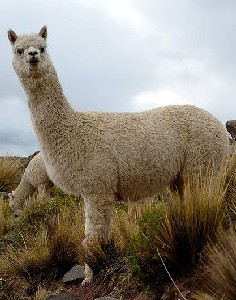
Photographer: Christophe Meneboeuf
"Hey, who you callin' ugly, bub?"
In fact, he was often referred to as 'Dr. Quicksilver.' However, he has a rather pithy, amusing and, many ways, accurate view of the efficacy of the bezoar stone.
We should likewise be at a Loss for Bezoar, that petrified Matter of Disease, cut out of the Paunches, Galls, and Bladders of some of the nastiest Creatures in being, as Guananoes [Guanacos], a monstrous Beast between a Camel and a He-Goat, black Cattle, Hogs, Goats and an ugly animal they call Pacos de la Tierra [the alpaca], Monkeys, Porcupines, and all such nasty animals. Of this I have been credibly informed by Persons of the best Reputation, both in the East and West Indies.
We, in Dissections, too often find in the Galls and Bladders of Human Bodies great Quantities of Stones, which doubtless may as well serve for Bezoar as the diseased matter of the afore-mentioned Beasts. They for the most Part dying with these Several Sorts of Stones, as by Experience 'tis daily seen we do.4
1 Ambroise Paré, The Workes of that Famous Chirurgion Ambrose Parey, p.529-30; 2 J.J. Kent, History of Usage of Bezoar Stones, gathered 3/30/13; 3 Robert James, Pharmacopœia universalis, p. 487; 4 Thomas Dover, The Ancient Physician's Legacy to his Country, p. 71

